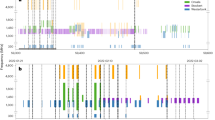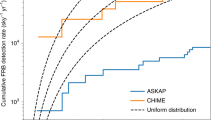Abstract
A network of cosmic strings generated in the early Universe may still exist today. As the strings move across the sky, they produce, by gravitational lensing, a characteristic pattern of anisotropies in the temperature of the cosmic microwave background. The observed absence of such anisotropies places constraints on theories in which galaxy formation is seeded by strings, but it is anticipated that the next generation of experiments will detect them.
This is a preview of subscription content, access via your institution
Access options
Subscribe to this journal
Receive 51 print issues and online access
$199.00 per year
only $3.90 per issue
Buy this article
- Purchase on Springer Link
- Instant access to full article PDF
Prices may be subject to local taxes which are calculated during checkout
Similar content being viewed by others
References
Brandenberger, R. Int. J. mod. Phys. A2, 77–131 (1987).
Vilenkin, A. Phys. Rev. D 24, 2082–2089 (1981).
Kaiser, N. & Stebbins, A. Nature 310, 391–393 (1984).
Gott, R. Astrophys. J. 288, 422–427 (1985).
Bennett, D. P. & Bouchet, F. R. Phys. Rev. Lett. 60, 257–260 (1988).
Bouchet, F. R. 8th Moriond Astrophysics Meeting: Dark Matter (ed. Frontieres, initial?) (Reidel, Dordrecht) (in the press).
Albrecht, A. & Turok, N. Phys. Rev. Lett. 54, 1868–1871 (1985).
Stebbins, A. Astrophys. J. 327, 584–613 (1988).
Brandenberger, R. & Turok, N. Phys. Rev. D 33, 2182–2195 (1986).
Traschen, J., Turok, N. & Brandenberger, R. Phys. Rev. D 34, 919–930 (1986).
Melchiorri, F., Melchiorri, B., Ceccarelli, C. & Pietranera, L. Astrophys. J. 250, LI (1981).
Readhead, A. & Sargeant, W. in IAU Symposium 130: Large Scale Structure of the Universe (ed. Audouze, J.) (Reidel, Dordrecht, 1988).
Hogan, C. J. & Rees, M. J. Nature 311, 109–114 (1984).
Davis, R. L. Phys. Lett. 161B, 285–288 (1985).
Bennett, D. P. Phys. Rev. D 34, 3592–3607 (1986).
Silk, J. & Vilenkin, A. Phys. Rev. Lett. 53, 1700–1703 (1984).
Turok, N. & Brandenberger, R. H. Phys. Rev. D 33, 2175–2181 (1986).
Brandenberger, R., Kaiser, N., Schramm, D. & Turok, N. Phys. Rev. Lett. 59, 2371–2374 (1987).
Bertschinger, E. & Watts, P. N. Astrophys. J. 328, 23–33 (1988).
Author information
Authors and Affiliations
Rights and permissions
About this article
Cite this article
Bouchet, F., Bennett, D. & Stebbins, A. Patterns of the cosmic microwave background from evolving string networks. Nature 335, 410–414 (1988). https://doi.org/10.1038/335410a0
Received:
Accepted:
Issue Date:
DOI: https://doi.org/10.1038/335410a0
This article is cited by
-
Simulations of the microwave sky and of its “observations”
Space Science Reviews (1995)
-
Microwave anisotropies from cosmic defects
Nature (1994)
-
Anisotropy measurements of the cosmic microwave background radiation at intermediate angular scales
Nature (1992)
Comments
By submitting a comment you agree to abide by our Terms and Community Guidelines. If you find something abusive or that does not comply with our terms or guidelines please flag it as inappropriate.



